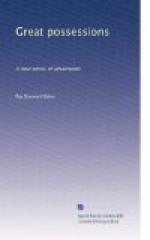As I walked down quickly into the field with my pitchfork on my shoulder to help Bill with the hay, I was startled to see, hanging upon a peach tree at the corner of the orchard, a complete suit of black clothes. Near it, with the arms waving gently in the breeze, was a white shirt and a black tie, and at the foot of the tree a respectable black hat. It was as though the peach tree had suddenly, on that bright day, gone into mourning.
I laughed to myself.
“Bill,” I said, “what does this mean?”
Bill is a stout jolly chap with cheeks that look, after half a day’s haying, like raw beef-steaks. He paused on his load, smiling broadly, his straw hat set like a halo on the back of his head.
“Expected a funeral,” he said cheerfully.
Bill is the undertaker’s assistant, and is always on call in cases of emergency.
“What happened, Bill?”
“They thought they’d bury ‘im this afternoon, but they took an’ kep’ ’im over till to-morrow.”
“But you came prepared.”
“Yas, no time to go home in hayin’. The pump fer me, and the black togs.”
Bill calls the first rakings of the hay “tumbles,” and the scattered re-rakings, which he despises, he calls “scratchings.” I took one side of the load and John, the Pole, the other and we put on great forkfuls from the tumbles which Bill placed skilfully at the corners and sides of the load, using the scratchings for the centre.
John, the Pole, watched the load from below. “Tank he too big here,” he would say, or, “Tank you put more there”; but Bill told mostly by the feel of the load under his feet or by the “squareness of his eye.” John, the Pole, is a big, powerful fellow, and after smoothing down the load with his fork he does not bother to rake up the combings, but gathering a bunch of loose hay with his fork, he pushes it by main strength, and very quickly, around the load, and running his fork through the heap, throws it upon the mountain-high load in a twinkling—an admirable, deft performance.
Hay-making is a really beautiful process: the clicking mower cutting its clean, wide swath, a man stepping after, where the hay is very heavy, to throw the windrow back a little. Then, after lying to wilt and dry in the burning sun—all full of good odours—the horse-rake draws it neatly into wide billows, and after that, John, the Pole, and I roll the billows into tumbles. Or, if the hay is slow in drying, as it was not this year, the kicking tedder goes over it, spreading it widely. Then the team and rack on the smooth-cut meadow and Bill on the load, and John and I pitching on; and the talk and badinage that goes on, the excitement over disturbed field mice, the discussion of the best methods of killing woodchucks, tales of marvellous exploits of loaders and stackers, thrilling incidents of the wet year of ’98 when two men and one team saved four acres of hay by working all night—“with lanterns, I jing”—much talk of how she goes on, “she” being the hay, and no end of observations upon the character, accomplishments, faults, and excesses of the sedate old horses waiting comfortably out in front, half hidden by the mountain of hay above them and nibbling at the tumbles as they go by.




